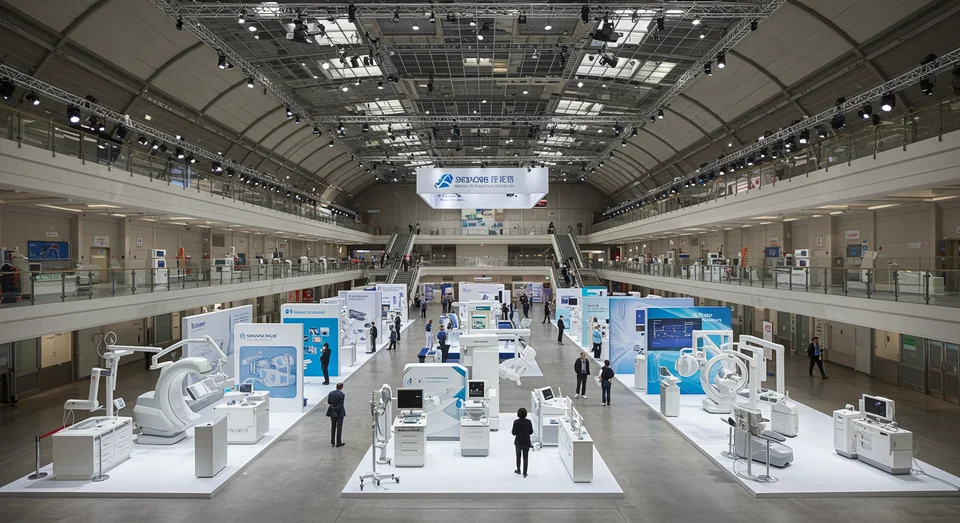CMEF 2025 Showcases Global Medical Innovation, AI Breakthroughs, and Cutting-Edge Imaging Technologies
153 views
The 91st China International Medical Equipment Fair (CMEF) concluded in Shanghai, leaving an indelible mark on the global healthcare industry. With nearly 5,000 exhibitors and attendees hailing from over 150 countries, the event transformed the sprawling halls of the National Exhibition and Convention Center into a vibrant showcase of medical innovation. From groundbreaking AI-driven technologies to the unveiling of ultra-high-definition imaging devices, the fair underscored its role as a crucible for the future of medical equipment.

A Global Stage for Medical Innovation: Highlights from CMEF 2025
The CMEF, often described as the heartbeat of medical equipment advancements, once again proved its mettle by bringing together industry leaders, small and medium-sized enterprises (SMEs), and national delegations under one roof. Among the standout product launches, GE Healthcare's SIGNA™ Hero MRI system captured widespread attention for its promise of enhanced diagnostic precision and patient comfort. Meanwhile, United Imaging Healthcare unveiled its uAI NEXUS medical foundation model, an AI-driven innovation poised to redefine the boundaries of predictive diagnostics and personalized medicine. Neusoft Medical, another major player, introduced an ultra-high-definition spiral CT scanner that promises to elevate imaging clarity to unprecedented levels.
The event’s International Zone added a layer of intrigue with its "Novel Product Pavilion," a curated space dedicated to cutting-edge technologies that hold the potential to reshape healthcare delivery. This pavilion welcomed contributions from SMEs alongside national pavilions, including Italy's Trade Agency and Pakistan Trade Development Authority. Such diversity not only underscored the CMEF's global appeal but also highlighted the collaborative spirit driving medical innovation across borders.
Beyond the product launches, the fair offered attendees a glimpse into emerging trends that are poised to redefine healthcare in the coming years. Robotic surgery tools, wearable health monitoring devices, and AI-powered diagnostic platforms were among the technologies that sparked conversations about accessibility, efficiency, and the future of patient care.
Bridging Borders, Building Futures
The CMEF has long been more than just a trade fair; it serves as a dynamic platform for fostering international cooperation and dialogue within the medical sector. This year’s event exemplified its role as a melting pot of ideas and expertise, with exhibitors ranging from global giants to nimble startups. The presence of national pavilions further emphasized the importance of cross-border collaboration in driving healthcare advancements. Italy’s Trade Agency, for instance, showcased solutions rooted in precision engineering and design, while Pakistan’s Trade Development Authority highlighted innovations tailored to the unique challenges of developing healthcare systems.
Such exchanges are not merely symbolic; they are essential in a world where healthcare needs vary dramatically across regions. The CMEF’s ability to unite stakeholders from diverse backgrounds speaks to its enduring relevance, even as the industry grapples with challenges like rising costs, regulatory complexities, and the ethical implications of AI-driven healthcare.
The fair’s influence is set to ripple beyond Shanghai, with upcoming events like tHIS ASEAN in Malaysia this July and the 92nd CMEF in Guangzhou this September. These gatherings promise to continue the dialogue initiated in Shanghai, offering new opportunities for collaboration and innovation.
The Road Ahead: Reflections on CMEF’s Role
As the curtains fall on the 91st CMEF, it is worth pondering the broader implications of such events in shaping the trajectory of global healthcare. The fair’s ability to attract exhibitors and attendees from over 150 countries underscores the universal nature of healthcare challenges and the shared commitment to addressing them. From AI-driven models that promise to democratize access to diagnostics to imaging systems that push the boundaries of what is medically possible, the innovations showcased at CMEF are not just technological marvels—they are harbingers of a more connected and equitable healthcare future.
Yet, the road ahead is not without its hurdles. The integration of AI into healthcare, while promising, raises questions about data privacy, algorithmic bias, and the role of human oversight in medical decision-making. Similarly, the push for ultra-high-definition imaging technologies must be balanced against concerns about cost and accessibility, particularly in under-resourced regions.
Events like CMEF play a crucial role in addressing these challenges by fostering dialogue and collaboration. They provide a platform for stakeholders to not only showcase their innovations but also engage in critical conversations about the ethical, logistical, and economic dimensions of healthcare advancement.
As the industry looks toward the next chapter—with tHIS ASEAN and the 92nd CMEF on the horizon—the lessons and innovations from Shanghai will undoubtedly serve as guiding lights. The fair’s ability to bring together diverse voices and perspectives is a testament to the power of collaboration in driving meaningful change. In the end, the CMEF is more than an event; it is a catalyst for progress, a reminder that the pursuit of better healthcare is a shared journey that transcends borders and boundaries.
